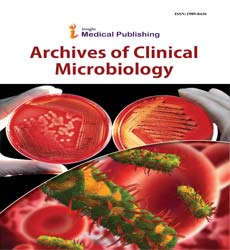Abstract
Microbial Profile of Burn Wound Infections in Burn Patients, Taif, Saudi Arabia
The major challenge for a burn team is nosocomial infection in burn patients, which is known to cause over 50% of burn deaths, and represents a serious health problem in burn wound patients,Taif, Sudia Arabia.
Aim: To determine Microbial Profile of Burn Wound Infections in Burn Patients,Taif, Saudi Arabia.
Method: 220 patients were included in the study. Woundswab cultures were assessed at day 4. Two hundred and twenty sampling procedures (surface swabs) were performed from the burn wounds.
Result: The study revealed that bacterial infection at least once reached 100% by the end of the 4th week of admission. Staphylococcus aureus, Klebsiella pneumoniae and coagulase negative Staphylococci were the most frequently isolated organisms, each representing 20.2%, followed by Pseudomonas aeruginosa 14.6% and E. coli 10.1%. Fungi were found to cause burn wound invasion late during the second week post burn, with the highest incidence during the fourth week, reaching 36% by the end of the 4th week of admission. Candida spp. (66.7%). The susceptibility pattern of 745 bacteria isolated against 20 antimicrobial agents. All strains were susceptible to all antibiotic; resistance was observed in some strains.
Conclusion: This would enable early treatment of imminent septic episodes with proper empirical systemic antibiotics, without waiting for culture results, thus improving the overall infection related morbidity and mortality.
Author(s):
Khadijah Yousef AL-Aali
Abstract | Full-Text | PDF
Share this

Abstracted/Indexed in
- Google Scholar
- Open J Gate
- Genamics JournalSeek
- The Global Impact Factor (GIF)
- Open Archive Initiative
- China National Knowledge Infrastructure (CNKI)
- Scimago
- Directory of Research Journal Indexing (DRJI)
- WorldCat
- Proquest Summons
- Publons
- MIAR
- ResearchGate
- University Grants Commission
- Geneva Foundation for Medical Education and Research
- Secret Search Engine Labs
Open Access Journals
- Aquaculture & Veterinary Science
- Chemistry & Chemical Sciences
- Clinical Sciences
- Engineering
- General Science
- Genetics & Molecular Biology
- Health Care & Nursing
- Immunology & Microbiology
- Materials Science
- Mathematics & Physics
- Medical Sciences
- Neurology & Psychiatry
- Oncology & Cancer Science
- Pharmaceutical Sciences

